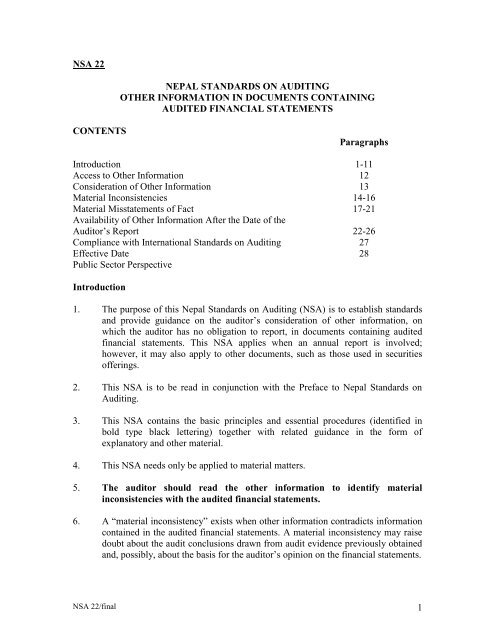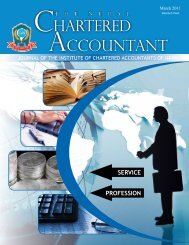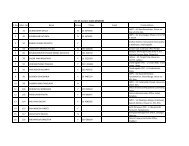INTERNATIONAL STANDARD ON AUDITING 720
INTERNATIONAL STANDARD ON AUDITING 720
INTERNATIONAL STANDARD ON AUDITING 720
You also want an ePaper? Increase the reach of your titles
YUMPU automatically turns print PDFs into web optimized ePapers that Google loves.
NSA 22<br />
C<strong>ON</strong>TENTS<br />
NEPAL <strong>STANDARD</strong>S <strong>ON</strong> <strong>AUDITING</strong><br />
OTHER INFORMATI<strong>ON</strong> IN DOCUMENTS C<strong>ON</strong>TAINING<br />
AUDITED FINANCIAL STATEMENTS<br />
Paragraphs<br />
Introduction 1-11<br />
Access to Other Information 12<br />
Consideration of Other Information 13<br />
Material Inconsistencies 14-16<br />
Material Misstatements of Fact 17-21<br />
Availability of Other Information After the Date of the<br />
Auditor’s Report 22-26<br />
Compliance with International Standards on Auditing 27<br />
Effective Date 28<br />
Public Sector Perspective<br />
Introduction<br />
1. The purpose of this Nepal Standards on Auditing (NSA) is to establish standards<br />
and provide guidance on the auditor’s consideration of other information, on<br />
which the auditor has no obligation to report, in documents containing audited<br />
financial statements. This NSA applies when an annual report is involved;<br />
however, it may also apply to other documents, such as those used in securities<br />
offerings.<br />
2. This NSA is to be read in conjunction with the Preface to Nepal Standards on<br />
Auditing.<br />
3. This NSA contains the basic principles and essential procedures (identified in<br />
bold type black lettering) together with related guidance in the form of<br />
explanatory and other material.<br />
4. This NSA needs only be applied to material matters.<br />
5. The auditor should read the other information to identify material<br />
inconsistencies with the audited financial statements.<br />
6. A “material inconsistency” exists when other information contradicts information<br />
contained in the audited financial statements. A material inconsistency may raise<br />
doubt about the audit conclusions drawn from audit evidence previously obtained<br />
and, possibly, about the basis for the auditor’s opinion on the financial statements.<br />
NSA 22/final 1
7. An entity ordinarily issues on an annual basis a document which includes its<br />
audited financial statements together with the auditor’s report thereon. This<br />
document is frequently referred to as the “annual report.” In issuing such a<br />
document, an entity may also include, either by law or custom, other financial and<br />
non-financial information. For the purpose of this NSA, such other financial and<br />
non-financial information is called “other information.”<br />
8. Examples of other information include a report by management or the board of<br />
directors on operations, financial summaries or highlights, employment data,<br />
planned capital expenditures, financial ratios, names of officers and directors and<br />
selected quarterly data.<br />
9. In certain circumstances, the auditor has a statutory or contractual obligation to<br />
report specifically on other information. In other circumstances, the auditor has no<br />
such obligation. However, the auditor needs to give consideration to such other<br />
information when issuing a report on the financial statements, as the credibility of<br />
the audited financial statements may be undermined by inconsistencies which<br />
may exist between the audited financial statements and other information.<br />
10. Some jurisdictions require the auditor to apply specific procedures to certain of<br />
the other information, for example, required supplementary data and interim<br />
financial information. If such other information is omitted or contains<br />
deficiencies, the auditor may be required to refer to the matter in the auditor’s<br />
report.<br />
11. When there is an obligation to report specifically on other information, the<br />
auditor’s responsibilities are determined by the nature of the engagement and by<br />
legislation and professional standards. When such responsibilities involve the<br />
review of other information, the auditor will need to follow the guidance on<br />
review engagements in the appropriate NSAs.<br />
<strong>AUDITING</strong><br />
Access to Other Information<br />
12. In order that an auditor can consider other information included in the annual<br />
report, timely access to such information will be required. The auditor therefore<br />
needs to make appropriate arrangements with the entity to obtain such<br />
information prior to the date of the auditor’s report. In certain circumstances, all<br />
the other information may not be available prior to such date. In these<br />
circumstances, the auditor would follow the guidance in paragraphs 23-26.<br />
Consideration of Other Information<br />
13. The objective and scope of an audit of financial statements are formulated on the<br />
premise that the auditor’s responsibility is restricted to information identified in<br />
the auditor’s report. Accordingly, the auditor has no specific responsibility to<br />
determine that other information is properly stated.<br />
NSA 22/final 2
Material Inconsistencies<br />
14. If, on reading the other information, the auditor identifies a material<br />
inconsistency, the auditor should determine whether the audited financial<br />
statements or the other information needs to be amended.<br />
15. If an amendment is necessary in the audited financial statements and the<br />
entity refuses to make the amendment, the auditor should express a qualified<br />
or adverse opinion.<br />
16. If an amendment is necessary in the other information and the entity refuses<br />
to make the amendment, the auditor should consider including in the<br />
auditor’s report an emphasis of matter paragraph describing the material<br />
inconsistency or taking other actions. The actions taken, such as not issuing the<br />
auditor’s report or withdrawing from the engagement, will depend upon the<br />
particular circumstances and the nature and significance of the inconsistency. The<br />
auditor would also consider obtaining legal advice as to further action.<br />
Material Misstatements of Fact<br />
17. While reading the other information for the purpose of identifying material<br />
inconsistencies, the auditor may become aware of an apparent material<br />
misstatement of fact.<br />
18. For the purpose of this NSA, a “material misstatement of fact” in other<br />
information exists when such information, not related to matters appearing in the<br />
audited financial statements, is incorrectly stated or presented.<br />
19. If the auditor becomes aware that the other information appears to include a<br />
material misstatement of fact, the auditor should discuss the matter with the<br />
entity’s management. When discussing the matter with the entity’s management,<br />
the auditor may not be able to evaluate the validity of the other information and<br />
management’s responses to the auditor’s inquiries, and would need to consider<br />
whether valid differences of judgement or opinion exist.<br />
20. When the auditor still considers that there is an apparent misstatement of<br />
fact, the auditor should request management to consult with a qualified third<br />
party, such as the entity’s legal counsel and should consider the advice<br />
received.<br />
21. If the auditor concludes that there is a material misstatement of fact in the<br />
other information which management refuses to correct, the auditor should<br />
consider taking further appropriate action. The actions taken could include<br />
such steps as notifying those persons ultimately responsible for the overall<br />
direction of the entity in writing of the auditor’s concern regarding the other<br />
information and obtaining legal advice.<br />
NSA 22/final 3
Availability of Other Information After the Date of the Auditor’s Report<br />
22. When all the other information is not available to the auditor prior to the date of<br />
the auditor’s report, the auditor would read the other information at the earliest<br />
possible opportunity thereafter to identify material inconsistencies.<br />
23. If, on reading the other information, the auditor identifies a material inconsistency<br />
or becomes aware of an apparent material misstatement of fact, the auditor would<br />
determine whether the audited financial statements or the other information need<br />
revision.<br />
24. When revision of the audited financial statements is appropriate, the guidance in<br />
NSA 16, “Subsequent Events” would be followed.<br />
25 When revision of the other information is necessary and the entity agrees to make<br />
the revision, the auditor would carry out the procedures necessary under the<br />
circumstances. The procedures may include reviewing the steps taken by<br />
management to ensure that individuals in receipt of the previously issued financial<br />
statements, the auditor’s report thereon and the other information are informed of<br />
the revision.<br />
26. When revision of the other information is necessary but management refuses<br />
to make the revision, the auditor should consider taking further appropriate<br />
action. The actions taken could include such steps as notifying those persons<br />
ultimately responsible for the overall direction of the entity in writing of the<br />
auditor’s concern regarding the other information and obtaining legal advice.<br />
Compliance with International Standards on Auditing<br />
27. Compliance with this NSA ensures compliance in all material respects with ISA<br />
<strong>720</strong> (Other Information in Documents Containing Audited Financial Statements).<br />
Effective Date<br />
28. This Nepal Standards on Auditing becomes operative for the audit commencing<br />
on or after 01 Magh 2061 corresponding to 14 January 2005. Earlier application is<br />
encouraged.<br />
AUDIING<br />
Public Sector Perspective<br />
1. This NSA is applicable in the context of the audit of financial statements. In the<br />
public sector, the auditor may often have a statutory or contractual obligation to<br />
report specifically on other information. As paragraph 11 of this NSA indicates,<br />
the procedures stated in this NSA would not be adequate to satisfy legislative or<br />
other audit requirements related to, for example, the expression of an opinion on<br />
the reliability of performance indicators and other information contained in the<br />
NSA 22/final 4
annual report. It would be inappropriate to apply this NSA in circumstances<br />
where the auditor does have an obligation to express an opinion on such<br />
information. In the absence of specific auditing requirements in relation to “other<br />
information,” the broad principles contained in this NSA are applicable.<br />
NSA 22/final 5




